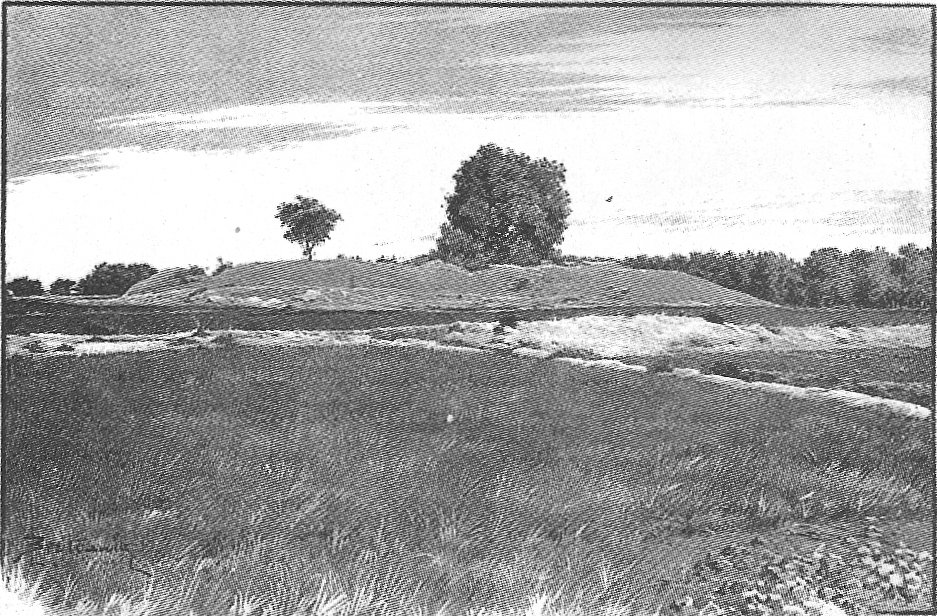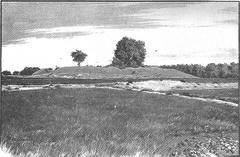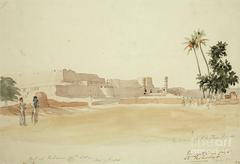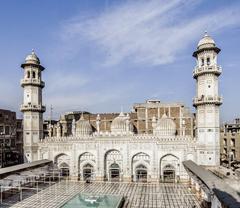
Kanishka Stupa Visiting Hours, Tickets, and Travel Guide in Peshawar
Date: 14/06/2025
Introduction to the Kanishka Stupa and Its Historical Significance
Nestled near the ancient city of Peshawar, Pakistan, the Kanishka Stupa stands as a monumental testament to the Kushan Empire’s religious devotion, cultural syncretism, and architectural innovation. Erected during the reign of Emperor Kanishka I (circa 127–150 CE), this Buddhist monument was once among the world’s tallest stupas, with estimates of its original height ranging from 120 to over 200 meters. It served as a key pilgrimage destination, attracting devotees and scholars from across Asia (Sino-Platonic Papers; Astana Times).
The stupa’s significance was further highlighted by the discovery of the famed Kanishka casket in the early 20th century—a reliquary believed to contain bone fragments of the Buddha, now housed in both the Peshawar Museum and Mandalay, Myanmar. Today, the original site exists as an archaeological mound in Akhunabad, with minimal visitor infrastructure, reflecting the broader challenges of heritage preservation in a rapidly urbanizing environment (Wikipedia; Dunya News).
This detailed guide explores the stupa’s rich history, its unique architectural features, and its enduring cultural impact. It also provides essential visitor information, including opening hours, ticketing, accessibility, nearby attractions, and travel tips for exploring this remarkable relic of Buddhist and South Asian history (Peshawar Insider; Trango Adventure).
Table of Contents
- Introduction
- Historical Background and the Kushan Empire
- Construction and Architectural Features
- Artistic and Cultural Influence
- Later History and Archaeological Rediscovery
- Visiting the Kanishka Stupa: Essential Information
- Frequently Asked Questions (FAQ)
- Preservation Status and Future Prospects
- Summary and Visitor Recommendations
- Sources and Further Reading
Historical Background and the Kushan Empire
The Kanishka Stupa’s origins are intertwined with the rise of the Kushan Empire under Emperor Kanishka I (Sino-Platonic Papers). The Kushans, of Yuezhi origin, ruled a vast territory stretching from Central Asia to northern India and held sway over a vital segment of the Silk Road. This network facilitated not just trade, but also the exchange of religious, philosophical, and artistic ideas.
Kanishka the Great is particularly celebrated for his patronage of Buddhism. His reign marked a period of remarkable expansion and cosmopolitanism, with Peshawar (then Purushapura) emerging as a major center of Buddhist learning and pilgrimage.
Construction and Architectural Features
Site Selection and Religious Motivation
The stupa was built outside the Gunj Gate in Akhunabad, as prophesied by Buddhist tradition and described by Chinese pilgrims Faxian and Xuanzang (Peshawar Insider; Sino-Platonic Papers). Kanishka’s embrace of Mahayana Buddhism and his aspiration to create a monumental reliquary for the Buddha’s remains fueled the construction.
Architectural Scale and Details
Ancient accounts describe the Kanishka Stupa as a towering structure, possibly exceeding 200 meters—making it a marvel of its era (Sino-Platonic Papers). Key features included:
- Square Plinth: Measuring roughly 83 meters wide, the plinth had projections on all sides, forming a cross-shaped platform.
- Superstructure: A massive cylindrical drum supported multiple terraces, crowned by a harmika and a multi-tiered chattravali.
- Corner Pillars: Four prominent pillars, possibly topped with lion capitals, reflected Gandharan and Hellenistic influences.
- Stucco Friezes: Later phases featured elaborate stucco decorations depicting Buddhas, a hallmark of Kashmiri art (Sino-Platonic Papers).
Construction Phases
- Early Phase: The site may have originally housed a wheel-shaped stupa built by earlier Kushan rulers.
- Kanishka’s Expansion: Kanishka’s project greatly enlarged or replaced the earlier structure.
- Repairs and Modifications: The stupa suffered fire damage in the 7th century, with subsequent repairs adding a cross-shaped platform and ornate stucco reliefs (Sino-Platonic Papers).
The Kanishka Casket and Relics
Excavations at Shah-ji-ki-Dheri in 1908–1909 uncovered the gilded copper Kanishka casket, inscribed with the emperor’s name and containing relics believed to be those of the Buddha (Sino-Platonic Papers). The casket is displayed at the Peshawar Museum and the British Museum, while the relics were transferred to Mandalay, Myanmar (Peshawar Museum Guide).
Artistic and Cultural Influence
The stupa’s construction coincided with the flourishing of the Gandhara School of Art—a unique blend of Greco-Roman, Indian, and Central Asian traditions. The site became a center for Buddhist sculpture, narrative reliefs, and architectural ornamentation, profoundly influencing Buddhist art in Central and East Asia.
Kanishka’s coins, depicting a wide range of deities, further reflect the era’s religious syncretism and cosmopolitanism.
Later History and Archaeological Rediscovery
The stupa remained a major pilgrimage site for centuries, as noted by Chinese and Islamic travelers. Over time, the decline of Buddhism in the region and repeated invasions led to the stupa’s ruin. Rediscovered in the 19th century and excavated in the early 20th, the site yielded invaluable artifacts and renewed scholarly interest.
Visiting the Kanishka Stupa: Essential Information
Location
- Site: Akhunabad, outside Gunj Gate of Peshawar’s old city
- Access: Easily reached by taxi or rickshaw from Peshawar city center (Wikipedia; Trango Adventure)
Visiting Hours
- Site: Open to the public at all times, as an undeveloped archaeological area. Daytime visits (9:00 AM–5:00 PM) are recommended for safety.
Tickets
- Entry: No ticket or entry fee is required. Donations for site maintenance are appreciated.
Accessibility
- Terrain: The mound is uneven and lacks developed pathways. Visitors with mobility challenges should use caution.
Guided Tours and Educational Resources
- Local Guides: Available through tour operators and at the Peshawar Museum.
- Tour Packages: Many operators offer combined tours of the stupa, Peshawar Museum, and other Gandharan sites (Trango Adventure).
Nearby Attractions
- Peshawar Museum: Home to the Kanishka casket and a rich collection of Gandharan artifacts.
- Bala Hisar Fort: Offers panoramic city views and military history.
- Mahabat Khan Mosque: Notable for its Mughal architecture.
- Qissa Khwani Bazaar: A traditional bazaar steeped in local culture.
Photography and Visuals
- On-site: The mound and surrounding ruins offer unique photography opportunities, especially at sunrise and sunset.
- Museum: The Peshawar Museum displays artifacts with informative labels and visual guides.
Frequently Asked Questions (FAQ)
Q: What are the visiting hours?
A: The site is open all day, but visiting during daylight is recommended for safety.
Q: Is there an entrance fee?
A: No, entry is free.
Q: Are guided tours available?
A: Yes, through local guides and tour operators.
Q: Is the site accessible for people with disabilities?
A: The terrain is uneven and not wheelchair-friendly.
Q: Where can I see artifacts from the Kanishka Stupa?
A: At the Peshawar Museum.
Preservation Status and Future Prospects
Current Site Condition
Today, the Kanishka Stupa is marked by an unprotected archaeological mound with little infrastructure (Wikipedia; Trango Adventure). Urban encroachment and lack of formal preservation pose significant threats to the site’s integrity (Tribune).
Preservation Advocacy
Historians and local advocates continue to call for the stupa’s recognition as a UNESCO World Heritage Site and for increased heritage protection (Dunya News). Recent heritage initiatives in Peshawar have focused on other historical sites, but there is hope that the stupa will receive similar attention.
Museum Conservation
While the archaeological site lacks development, the Peshawar Museum preserves key artifacts from the stupa, including the Kanishka casket (Trango Adventure).
Summary and Visitor Recommendations
The Kanishka Stupa remains an enduring symbol of the Kushan Empire’s architectural ambition and the spread of Buddhism across Asia. While the physical site consists mainly of an archaeological mound, its legacy is preserved through the artifacts at the Peshawar Museum and ongoing scholarly interest. Respectful, informed visitation—ideally during the cooler months (October to March)—and engagement with local guides will greatly enhance the experience. Preservation and recognition efforts remain critical to safeguarding this unique heritage for future generations (Astana Times; Dunya News).
For the latest visitor information and cultural insights, download the Audiala app or consult official tourism channels. Exploring the Kanishka Stupa and the wider heritage of Peshawar offers a unique journey into the heart of Gandharan civilization and Buddhist history (Trango Adventure; Peshawar Museum).
Sources and Further Reading
- Kanishka Stupa: History, Visiting Hours, Tickets, and Guide to This Iconic Peshawar Historical Site, 2025
- Visiting the Kanishka Stupa: Hours, Tickets, History, and Highlights in Peshawar, 2025
- Kanishka Stupa: A Historical and Visitor’s Guide to Peshawar’s Iconic Buddhist Monument, 2025
- Visiting the Kanishka Stupa in Peshawar: Hours, Tickets, and Historical Insights, 2025
- Kanishka Stupa preservation status and heritage concerns, 2025
- Peshawar Museum and Gandharan Art, 2025
- Guide to Peshawar and Nearby Attractions, 2025
- Heritage and Urban Development in Peshawar, 2025




